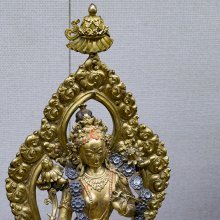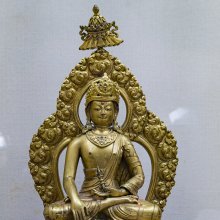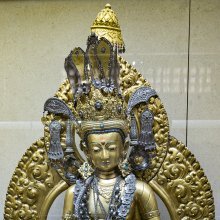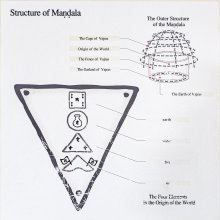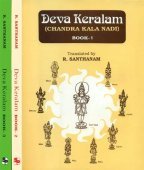Nirmala, Nirmalā: 26 definitions
Introduction:
Nirmala means something in Buddhism, Pali, Hinduism, Sanskrit, Jainism, Prakrit, Marathi, Hindi. If you want to know the exact meaning, history, etymology or English translation of this term then check out the descriptions on this page. Add your comment or reference to a book if you want to contribute to this summary article.
Alternative spellings of this word include Nirmal.
Images (photo gallery)
In Hinduism
Ayurveda (science of life)
Source: archive.org: Vagbhata’s Ashtanga Hridaya Samhita (first 5 chapters)Nirmala (निर्मल) refers to “devoid of dirt”, mentioned in verse 3.52-53 of the Aṣṭāṅgahṛdayasaṃhitā (Sūtrasthāna) by Vāgbhaṭa.—Accordingly, “[...] when hungry, one shall turn to bitter, sweet, astringent, and light food, [...]; to water [...] devoid of dirt [viz., nirmala], (and) destructive of dirt [...] (and that is) neither causative of effusions nor rough, (but) nectar-like among the beverages etc.; (and)—beautifully adorned) with sandal, cuscus, camphor, pearls, garlands, and (fine) clothes— [...]”.
Note: As nirmala (“devoid of dirt”) and malajit (“destructive of dirt”) in 52d, so abhiṣyandin (“causative of effusions”), rūkṣa (“rough”), and amṛtopama (“nectar-like”) have been put verbally: ’brag (for ’brub)—“causing effusions”, rtsub-pa yin-pa—“being
rough”, and bdud-rtsir mthsuṅs (“resembling nectar”).

Āyurveda (आयुर्वेद, ayurveda) is a branch of Indian science dealing with medicine, herbalism, taxology, anatomy, surgery, alchemy and related topics. Traditional practice of Āyurveda in ancient India dates back to at least the first millenium BC. Literature is commonly written in Sanskrit using various poetic metres.
Shaktism (Shakta philosophy)
Source: Google Books: Manthanabhairavatantram1) Nirmala (निर्मल) refers to “pure (i.e., a pure state)”, according to the Śrīmatottara-tantra, an expansion of the Kubjikāmatatantra: the earliest popular and most authoritative Tantra of the Kubjikā cult.—Accordingly, “By the practice of the Yoga of Stillness [i.e., nirācārayoga], one obtains the fruit. She whose nature is movement (cara) moves, (and her movement is) divided into (downward) motion (cāra) and upward motion (uccāra). That should be known as Stillness (nirācāra). Stillness is not other (than this). (This is) where actions (cāra) cease along with the activities (karman) of speech, mind, and body. When a pure (nirmala) state arises, that is said to be Stillness”.
2) Nirmala (निर्मल) refers to “stainless” (viz., stainless as pure crystal) and is used to describe Ardhanarīśvara, according to the second recension of the Yogakhaṇḍa of the Manthānabhairavatantra, a vast sprawling work that belongs to a corpus of Tantric texts concerned with the worship of the goddess Kubjikā.—Accordingly, as Bhadrakālī said to Śrīkaṇṭha: “[...] (You are) he, the Siddha who has been pierced (by the power of the Command) and, made of universal bliss, is accompanied by Yogeśvarī. [...] Beautiful he is, stainless as pure crystal [i.e., śuddhasphaṭika-nirmala]. (He is) the Lord (īśvara), supreme Śambhu, who bears a divine form and is auspicious. [...]”.

Shakta (शाक्त, śākta) or Shaktism (śāktism) represents a tradition of Hinduism where the Goddess (Devi) is revered and worshipped. Shakta literature includes a range of scriptures, including various Agamas and Tantras, although its roots may be traced back to the Vedas.
Jyotisha (astronomy and astrology)
Source: Wisdom Library: Brihat Samhita by VarahamihiraNirmala (निर्मल) refers to “purity”, according to the Bṛhatsaṃhitā (chapter 12), an encyclopedic Sanskrit work written by Varāhamihira mainly focusing on the science of ancient Indian astronomy astronomy (Jyotiṣa).—Accordingly, “When star Canopus reappears after its conjunction with the Sun, waters muddled by their contact with the earth will resume their original clearness just in the same way as the minds of the Sādhus naturally recover their original purity [i.e., nirmala] after contact with the wicked. The autumn is attended by the Cakravāka on both its sides (i.e., beginning and end); in it is heard the music of the swan; and its opening is marked by the beautiful red sky; in all these respects the season resembles a woman with a rising bosom, sounding jewels and betel-coloured mouth”.

Jyotisha (ज्योतिष, jyotiṣa or jyotish) refers to ‘astronomy’ or “Vedic astrology” and represents the fifth of the six Vedangas (additional sciences to be studied along with the Vedas). Jyotisha concerns itself with the study and prediction of the movements of celestial bodies, in order to calculate the auspicious time for rituals and ceremonies.
Shaivism (Shaiva philosophy)
Source: SOAS University of London: Protective Rites in the Netra TantraNirmala (निर्मल) refers to a “transparent (crystal)”, according to the Netratantra of Kṣemarāja: a Śaiva text from the 9th century in which Śiva (Bhairava) teaches Pārvatī topics such as metaphysics, cosmology, and soteriology.—Accordingly, [verse 9.5-11, while explaining the universality of Amṛteśa]—“Amṛteśa is supreme. He is free of disease. His nature is inherent, fully enumerated, constant, eternal, and immovable. [He has] no form or color, and is the highest truth. Because of that, he is omnipresent. The splendid Deva delights in all āgamas, pervades all mantras, and grants all siddhis. In this way, he is like a transparent crystal (nirmala—nirmalaṃ sphaṭikaṃ) sewn onto a colored thread, always reflected with its color, [and] seeking [to] look like this and that. [...]”.

Shaiva (शैव, śaiva) or Shaivism (śaivism) represents a tradition of Hinduism worshiping Shiva as the supreme being. Closely related to Shaktism, Shaiva literature includes a range of scriptures, including Tantras, while the root of this tradition may be traced back to the ancient Vedas.
Purana and Itihasa (epic history)
Source: archive.org: Shiva Purana - English TranslationNirmala (निर्मल) refers to a “pure (vision of knowledge)”, according to the Śivapurāṇa 2.3.33 (“The appeasement of Himavat”).—Accordingly, as Vasiṣṭha said to Himavat (Himācala): “O lord of mountains, listen to my words in every respect conducive to your welfare; they are not against virtue. They are true and shall bring about your joy here and hereafter. Statements, in ordinary language and in the Vedas, are of three forms. A scholar knowing all lores understands them by means of his pure (nirmala) vision of knowledge. [...]”.

The Purana (पुराण, purāṇas) refers to Sanskrit literature preserving ancient India’s vast cultural history, including historical legends, religious ceremonies, various arts and sciences. The eighteen mahapuranas total over 400,000 shlokas (metrical couplets) and date to at least several centuries BCE.
Yoga (school of philosophy)
Source: ORA: Amanaska (king of all yogas): A Critical Edition and Annotated Translation by Jason BirchNirmala (निर्मल) or Amala refers to “that which has no impurity”, and is used to describe Samādhi and Paratattva (highest reality), according to the Amanaska Yoga treatise which deals absorption, yogic powers and liberation.—The Amanaska referred to (or qualified) Samādhi with several terms, which are all negative; [e.g., it has no impurity (nirmala/amala);] [...] The fact that such terminology is found in the Amanaska indicates that descriptions of Śiva and the void-like meditative states in Mantramargic Śaivism, were the basis of the descriptions of Samādhi and Paratattva (the highest reality) in this treatise. The Amanaska Yoga was consistent with the Pātañjala Yogaśāstra’s definition of Yoga, yet it described Samādhi in terms different to those of Pātañjalayoga; such as Nirmala/Amala—“that which has no impurity”.

Yoga is originally considered a branch of Hindu philosophy (astika), but both ancient and modern Yoga combine the physical, mental and spiritual. Yoga teaches various physical techniques also known as āsanas (postures), used for various purposes (eg., meditation, contemplation, relaxation).
In Buddhism
Tibetan Buddhism (Vajrayana or tantric Buddhism)
Source: Wisdom Library: Tibetan BuddhismNirmalā (निर्मला) is the name of Vidyārājñī (i.e., “wisdom queen”) mentioned as attending the teachings in the 6th century Mañjuśrīmūlakalpa: one of the largest Kriyā Tantras devoted to Mañjuśrī (the Bodhisattva of wisdom) representing an encyclopedia of knowledge primarily concerned with ritualistic elements in Buddhism. The teachings in this text originate from Mañjuśrī and were taught to and by Buddha Śākyamuni in the presence of a large audience (including Nirmalā).
Source: Brill: Śaivism and the Tantric Traditions (tantric Buddhism)Nirmalā (निर्मला) refers to the “(that devotion which is) without blemish” according to Vāgīśvarakīrti’s Tattvaratnāvalokavivaraṇa.—Accordingly, “This is the work to dispel all opposed opinions of Vāgīśvara [Vāgīśvarakīrti], whose dedication to the glorious Samāja [Guhyasamāja] is supreme and whose devotion is without blemish (nirmalā)”.
Source: OSU Press: Cakrasamvara SamadhiNirmala (निर्मल) or Nirmalatīrtha refers to one of the “eleven holy bathing places” (Puṇyatīrtha), according to the Guru Mandala Worship (maṇḍalārcana) ritual often performed in combination with the Cakrasaṃvara Samādhi, which refers to the primary pūjā and sādhanā practice of Newah Mahāyāna-Vajrayāna Buddhists in Nepal.

Tibetan Buddhism includes schools such as Nyingma, Kadampa, Kagyu and Gelug. Their primary canon of literature is divided in two broad categories: The Kangyur, which consists of Buddha’s words, and the Tengyur, which includes commentaries from various sources. Esotericism and tantra techniques (vajrayāna) are collected indepently.
Mahayana (major branch of Buddhism)
Source: archive.org: Bulletin of the French School of the Far East (volume 5)Nirmala (निर्मल) is the name of a Kinnara appointed as one of the Divine protector deities of Śaya, according to chapter 17 of the Candragarbha: the 55th section of the Mahāsaṃnipāta-sūtra, a large compilation of Sūtras (texts) in Mahāyāna Buddhism partly available in Sanskrit, Tibetan and Chinese.—In the Candragarbhasūtra, the Bhagavat invites all classes of Gods and Deities to protect the Law [dharma?] and the faithful in their respective kingdoms of Jambudvīpa [e.g., the Kinnara Nirmala in Śaya], resembling the time of the past Buddhas.

Mahayana (महायान, mahāyāna) is a major branch of Buddhism focusing on the path of a Bodhisattva (spiritual aspirants/ enlightened beings). Extant literature is vast and primarely composed in the Sanskrit language. There are many sūtras of which some of the earliest are the various Prajñāpāramitā sūtras.
In Jainism
General definition (in Jainism)
Source: The University of Sydney: A study of the Twelve ReflectionsNirmala (निर्मल) refers to “spotless” (pure meditation), according to the 11th century Jñānārṇava, a treatise on Jain Yoga in roughly 2200 Sanskrit verses composed by Śubhacandra.—Accordingly, “Then the wise [man] who has gone beyond virtuous meditation and attained infinite purity commences to meditate on absolutely spotless (atyanta-nirmala) pure [meditation]. He who is endowed with a robust physique etc., calm [and] whose behaviour is virtuous is also capable of meditating on pure meditation which is of four kinds of”.
Synonyms: Sudhā, Śuddha.

Jainism is an Indian religion of Dharma whose doctrine revolves around harmlessness (ahimsa) towards every living being. The two major branches (Digambara and Svetambara) of Jainism stimulate self-control (or, shramana, ‘self-reliance’) and spiritual development through a path of peace for the soul to progess to the ultimate goal.
Languages of India and abroad
Marathi-English dictionary
Source: DDSA: The Molesworth Marathi and English Dictionarynirmala (निर्मल).—a (S) pop. nirmaḷa a Void of dirt or impurity, lit. fig., clean, clear, pure, unsullied, guileless: also unadulterated, unalloyed &c.
--- OR ---
nirmaḷā (निर्मळा).—m A tree, Strychnos potatorum. Rox.
Source: DDSA: The Aryabhusan school dictionary, Marathi-Englishnirmala (निर्मल).—a nirmaḷa a Void of dirt or impu- rity; clean, clear, pure. Unadulte- rated.
Marathi is an Indo-European language having over 70 million native speakers people in (predominantly) Maharashtra India. Marathi, like many other Indo-Aryan languages, evolved from early forms of Prakrit, which itself is a subset of Sanskrit, one of the most ancient languages of the world.
Sanskrit dictionary
Source: DDSA: The practical Sanskrit-English dictionaryNirmala (निर्मल).—a.
1) free from dirt or impurities, clear, pure, stainless, unsullied (fig. also); नीरान्निर्मलतो जनिः (nīrānnirmalato janiḥ) Bv.1.63.
2) resplendent, bright; Bhartṛhari 1.56.
3) sinless, virtuous; निर्मलाः स्वर्गमायान्ति सन्तः सुकृतिनो यथा (nirmalāḥ svargamāyānti santaḥ sukṛtino yathā) Manusmṛti 8.318. (-lam) 1 talc.
2) the remainings of an offering made to a deity. °उपलः (upalaḥ) a crystal.
Nirmala is a Sanskrit compound consisting of the terms nir and mala (मल).
Source: Cologne Digital Sanskrit Dictionaries: Edgerton Buddhist Hybrid Sanskrit DictionaryNirmala (निर्मल).—(1) name of a future Pratyekabuddha: Avadāna-śataka i.162.5; (2) name of a Buddha: Śikṣāsamuccaya 169.9.
Source: Cologne Digital Sanskrit Dictionaries: Shabda-Sagara Sanskrit-English DictionaryNirmala (निर्मल) or Nirmmala.—mfn.
(-laḥ-lā-laṃ) 1. Clear, clean, free from dirt or impurities, (literally or figuratively.) 2. Bright n.
(-laṃ) 1. The remains of an offering made to a deity. 2. Talc. E. nir priv. and nala dirt.
Source: Cologne Digital Sanskrit Dictionaries: Benfey Sanskrit-English DictionaryNirmala (निर्मल).—adj., f. lā. 1. stainless, [Hitopadeśa] i. [distich] 47, M. M. 2. pure, [Hitopadeśa] ii. [distich] 134; clear, [Pañcatantra] 248, 5. 3. bright, [Johnson's Selections from the Mahābhārata.] 12, 33.
Nirmala is a Sanskrit compound consisting of the terms nis and mala (मल).
Source: Cologne Digital Sanskrit Dictionaries: Cappeller Sanskrit-English DictionaryNirmala (निर्मल).—[adjective] stainless, clean, pure; [abstract] tā [feminine], tva [neuter]
Source: Cologne Digital Sanskrit Dictionaries: Monier-Williams Sanskrit-English Dictionary1) Nirmala (निर्मल):—[=nir-mala] [from nir > niḥ] mf(ā)n. spotless, unsullied, clean, pure, shining, resplendent, bright, [Upaniṣad; Mahābhārata; Kāvya literature] etc.
2) [v.s. ...] sinless, virtuous, [Manu-smṛti viii, 318]
3) [v.s. ...] m. Name of Skanda, [Atharva-veda.Pariś.]
4) [v.s. ...] m. [plural] Name of a sect, [Horace H. Wilson]
5) [v.s. ...] n. talc, [cf. Lexicographers, esp. such as amarasiṃha, halāyudha, hemacandra, etc.]
6) [v.s. ...] = nir-mālya n., [cf. Lexicographers, esp. such as amarasiṃha, halāyudha, hemacandra, etc.]
Source: Cologne Digital Sanskrit Dictionaries: Yates Sanskrit-English DictionaryNirmala (निर्मल):—[nir-mala] (laṃ) 1. n. Remains of an offering; talc. a. Pure, clean.
Source: DDSA: Paia-sadda-mahannavo; a comprehensive Prakrit Hindi dictionary (S)Nirmala (निर्मल) in the Sanskrit language is related to the Prakrit word: Ṇimmala.
[Sanskrit to German]
Sanskrit, also spelled संस्कृतम् (saṃskṛtam), is an ancient language of India commonly seen as the grandmother of the Indo-European language family (even English!). Closely allied with Prakrit and Pali, Sanskrit is more exhaustive in both grammar and terms and has the most extensive collection of literature in the world, greatly surpassing its sister-languages Greek and Latin.
Hindi dictionary
Source: DDSA: A practical Hindi-English dictionaryNirmala (निर्मल) [Also spelled nirmal]:—(a) clean; clear; pure; unsullied, spotless, stainless; ~[tā] cleanness; clearness; purity; stainlessness.
...
Kannada-English dictionary
Source: Alar: Kannada-English corpusNirmala (ನಿರ್ಮಲ):—
1) [adjective] free from any adulterant; unmixed.
2) [adjective] free from anything that taints, impairs, infects, etc.; clear; pure.
3) [adjective] spiritually perfect or pure; untainted by evil or sin; sinless; saintly.
--- OR ---
Nirmala (ನಿರ್ಮಲ):—
1) [noun] the quality of being free from adulterant.
2) [noun] the quality of being unstained, unimpaired, uninfected; purity.
3) [noun] spiritual purity or perfection; sinlessness; saintliness.
4) [noun] absence of mental agitation, fear, apprehension, etc.
5) [noun] great splendor.
6) [noun] a sinless, spotless, saintly man.
--- OR ---
Nirmaḷa (ನಿರ್ಮಳ):—[adjective] = ನಿರ್ಮಲ [nirmala]1.
--- OR ---
Nirmaḷa (ನಿರ್ಮಳ):—[noun] = ನಿರ್ಮಲ [nirmala]2 - 1, 2, 3, 4 & 5.
Kannada is a Dravidian language (as opposed to the Indo-European language family) mainly spoken in the southwestern region of India.
See also (Relevant definitions)
Starts with (+6): Nirmala bhatta, Nirmalabhatta, Nirmalacarya, Nirmalacitta, Nirmalacitte, Nirmaladarpana, Nirmalagada, Nirmalahridaya, Nirmalahridaye, Nirmalai, Nirmalajala, Nirmalakrishna, Nirmalam, Nirmalanjana, Nirmalaprakasha, Nirmalasahaja, Nirmalasphatika, Nirmalasthita, Nirmalata, Nirmalatai.
Ends with: Anirmala, Atyantanirmala, Paramanirmala, Parinirmala, Sunirmala, Suvinirmala, Vinirmala.
Full-text (+38): Anirmala, Nairmalya, Nirmalate, Taptakancana, Nirmalita, Nirmalata, Vinirmala, Nirmalike, Nimmala, Cubakalanem, Anirmalya, Nirmala bhatta, Avarshana, Ashtangayoga, Sunirmala, Nirumalatanam, Candrakanta, Nirmali, Nirmalam, Nirmal.
Relevant text
Search found 45 books and stories containing Nirmala, Nirmalā, Nirmaḷā, Nirmaḷa; (plurals include: Nirmalas, Nirmalās, Nirmaḷās, Nirmaḷas). You can also click to the full overview containing English textual excerpts. Below are direct links for the most relevant articles:
Garga Samhita (English) (by Danavir Goswami)
Verse 1.11.15 < [Chapter 11 - Description of Śrī Kṛṣṇacandra’s Birth]
Verse 5.24.93 < [Chapter 24 - The Killing of the Kola Demon]
Verse 3.2.28 < [Chapter 2 - The Great Festival of Śrī Girirāja]
Shrimad Bhagavad-gita (by Narayana Gosvami)
Verse 14.16 < [Chapter 14 - Guṇa-traya-vibhāga-yoga]
Sahitya-kaumudi by Baladeva Vidyabhushana (by Gaurapada Dāsa)
Text 7.60 < [Chapter 7 - Literary Faults]
Text 10.107 < [Chapter 10 - Ornaments of Meaning]
Text 10.163 < [Chapter 10 - Ornaments of Meaning]
Manusmriti with the Commentary of Medhatithi (by Ganganatha Jha)
Verse 11.250 < [Section XXXII - Expiation of Secret Sins]
Verse 8.318 < [Section XLIII - Theft (steya)]
Bhakti-rasamrta-sindhu (by Śrīla Rūpa Gosvāmī)
Verse 1.1.12 < [Part 1 - Qualities of Pure Bhakti (bhagavad-bhakti-bheda)]
Verse 2.1.139 < [Part 1 - Ecstatic Excitants (vibhāva)]
The Tattvasangraha [with commentary] (by Ganganatha Jha)
Verse 3452-3453 < [Chapter 26 - Examination of the ‘Person of Super-normal Vision’]
Related products
